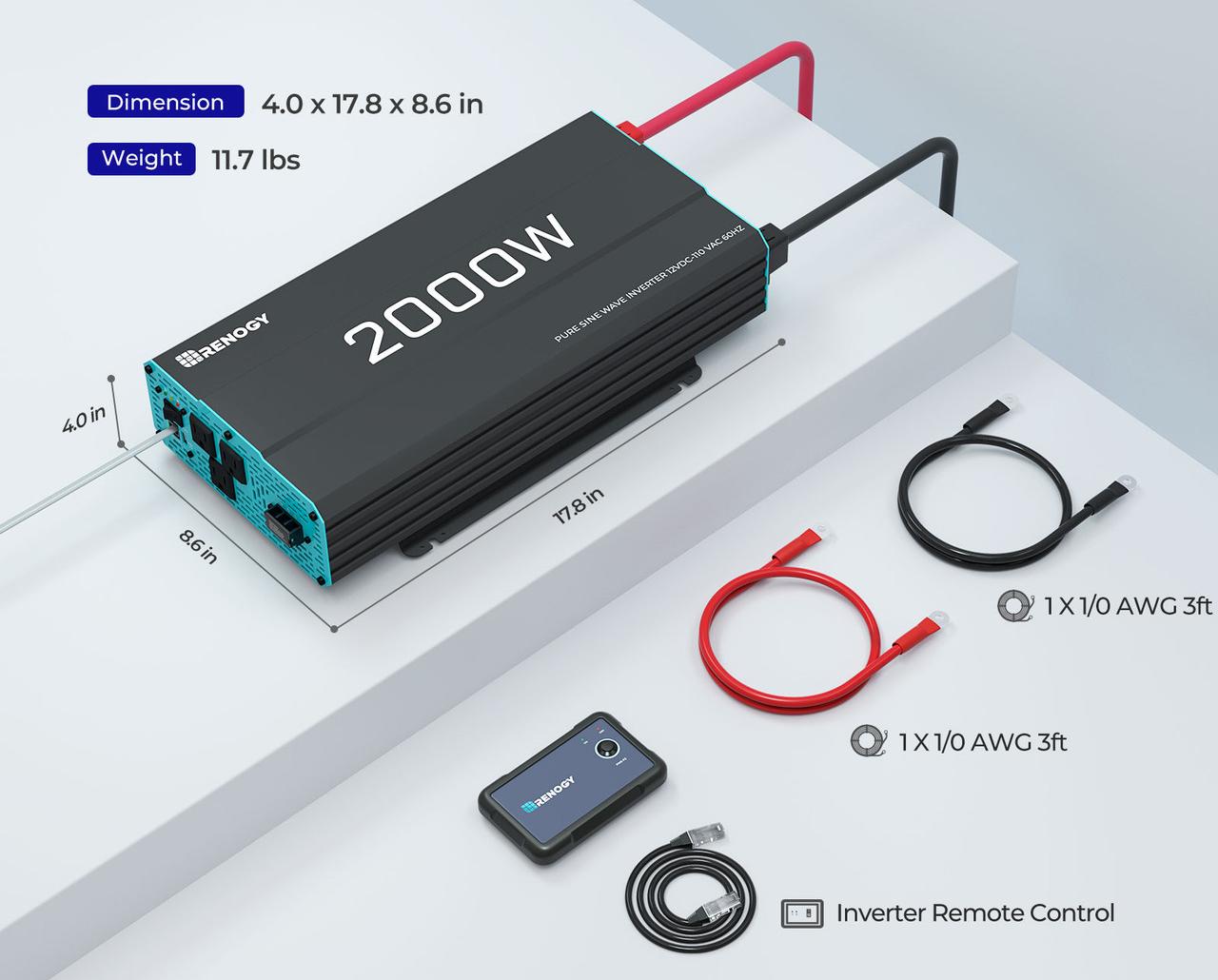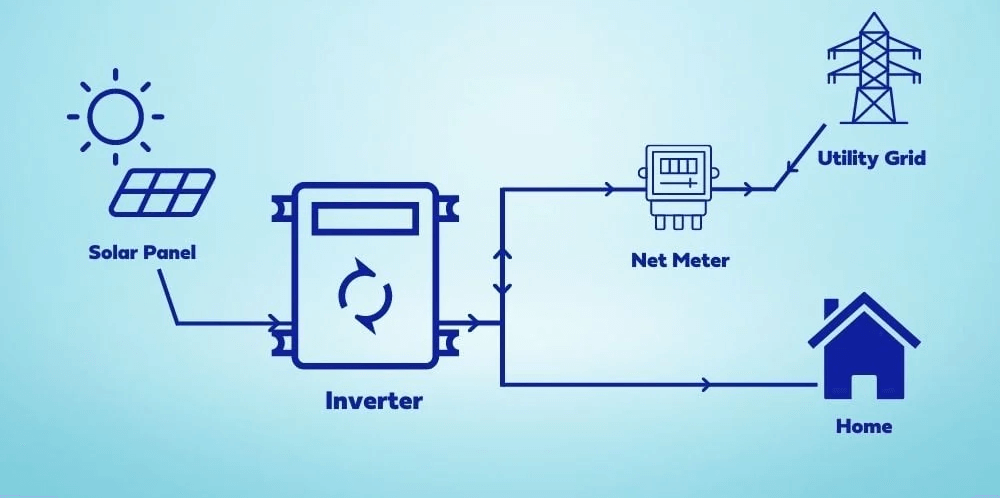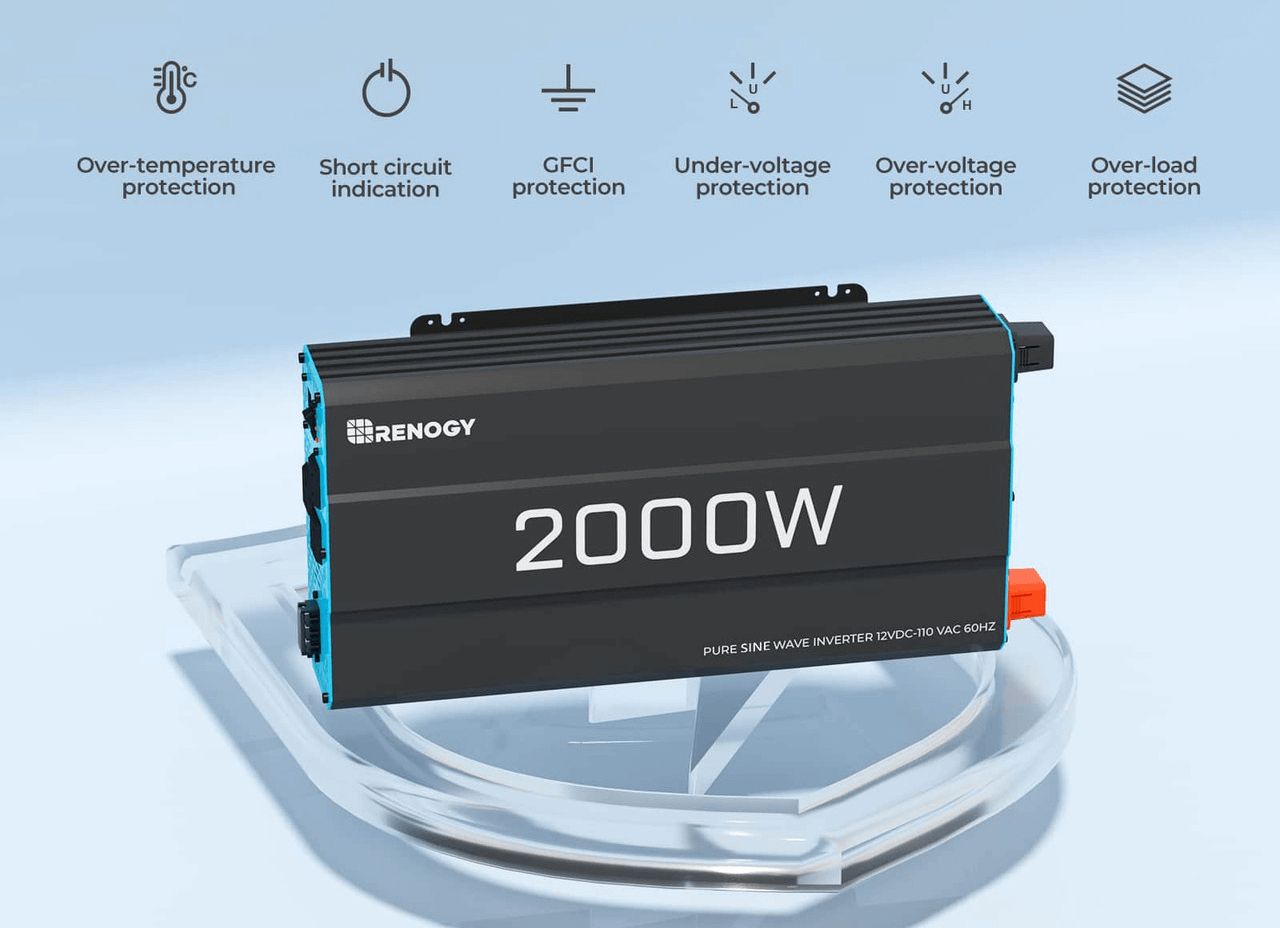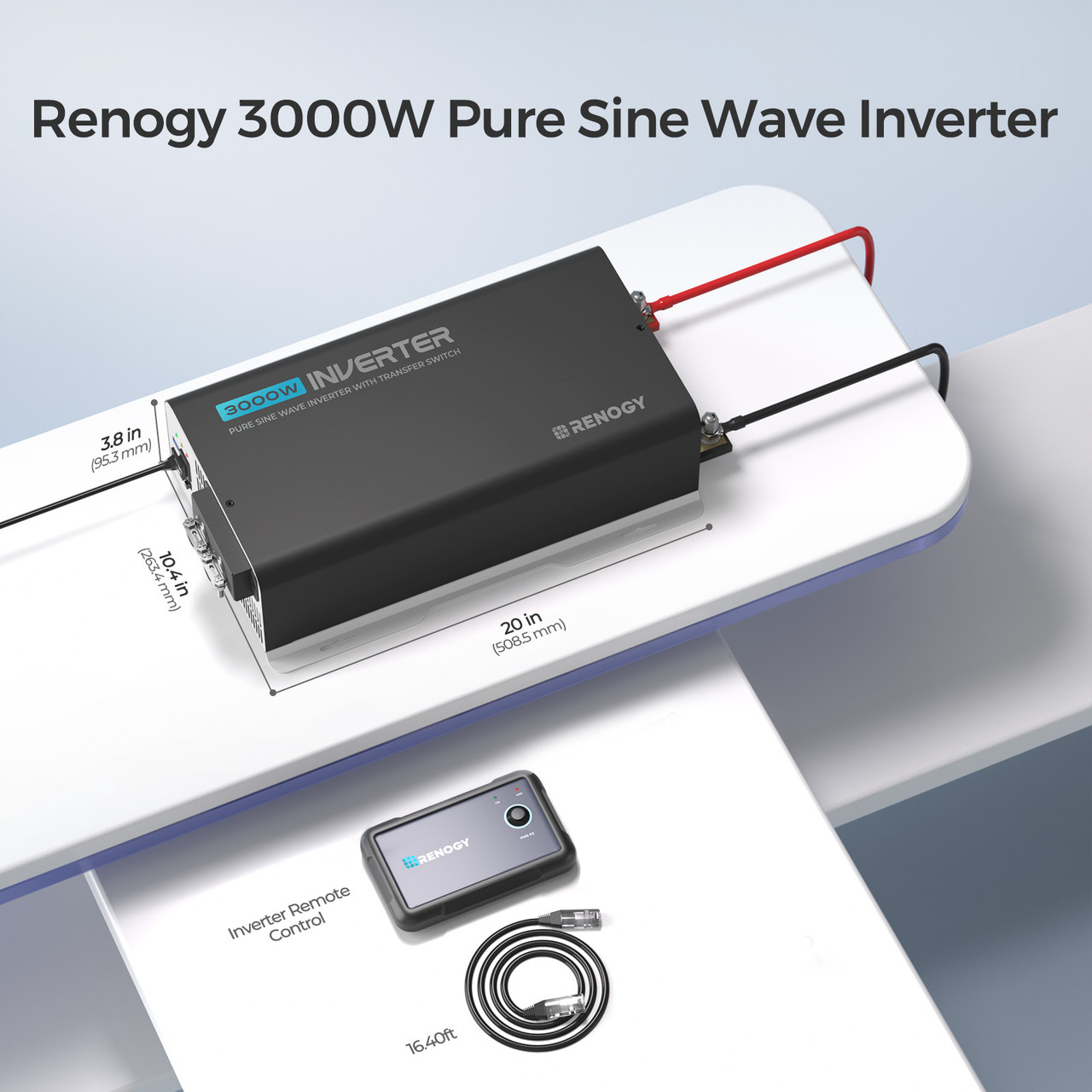Solar Inverter Buyers Guide for Beginners | Off-Grid Life
Off-grid living is one of the ways of achieving energy independence and living sustainably for the good of the environment. A good and complete solar system is a practical way of making your dream of off-grid living a reality. Therefore, some of the key solar system components you will need include solar panels, solar inverters, and batteries for energy storage. The role of the solar panel inverter is to transform the DC (direct current) into usable AC (alternating current) for home use.
This article seeks to guide you through understanding the various types of solar inverters and how they operate, as we recommend Renogy pure sine wave inverters for safety, reliability, high performance, and compatibility with most solar systems. Keep reading!
What Is a Solar Inverter and How Does It Work?

A solar inverter is a necessary component of the photovoltaic system. The solar inverter converts the DC electricity into usable AC electricity. The on-grid and off-grid inverters are designed differently. Off-grid inverters are not connected to the grid, while the on-grid is connected to the main utility grid. The role of an inverter is to manage the charging and discharging of the battery bank to ensure you have a continuous supply of electricity even during cloudy days.
How does a solar inverter work? The solar system produces electricity by utilizing solar panels. Solar panels have several photovoltaic cells that harness sunlight and convert it into direct current (DC). A solar inverter utilizes the solid-state components to convert the DC electricity to usable AC electricity. Unlike the traditional mechanical inverters, the modern solar inverters do not have moving parts. Instead, they use power semiconductors, such as diodes and transistors to switch DC on and off at an extremely high frequency. The rapid binary switching generates alternating current (AC), in pure sine waveform.
Pure sine wave electricity is the gold standard of AC waveforms because it is clean and free from any noise or distortion that may harm sensitive electronic devices when a low-quality inverter is used.
Types Of Solar Inverters
Solar inverters are categorized into two, on-grid inverters and off-grid inverters.
1. On-Grid Inverters

The on-grid inverters allow the home solar panel systems to shut down the power supply in case of an electrical arc. The on-grid solar inverters consist of the string inverters, the microinverters, and the power optimizers.
String Inverters
Also known as the central solar inverters, they are the oldest and most commonly used solar inverters. They connect several solar panels to one inverter that converts DC to AC output.
Micro Inverter
As the name suggests, microinverters are tiny power converters built into every solar panel. They allow each panel to perform optimally independently from other panels. Also, it allows you to easily monitor the efficiency and performance of each solar panel independently.
Power Optimizer
The power optimizer is usually installed at the back of every solar panel and operates in tandem with string inverters. It converts DC electricity to AC electricity. The DC electricity from every solar panel is conditioned and then sent to the string inverter, which converts it into AC electricity.
2. Off-Grid Inverters

The off-grid solar inverters withdraw electric power from a power bank, in case of a power outage or on cloudy days when there is no sunlight. The inverter converts the DC from the power storage to AC which is used for powering various appliances and devices.
The off-grid systems use batteries to store excess solar electricity generated by the solar panels. There are two main categories of off-grid solar inverters, the pure sine wave inverters and the modified sine wave inverters.
Pure Sine Wave Inverter

Pure sine wave inverters are the most common inverters because they are quiet and reliable. They are interface-free electricity for powering electronic appliances and devices. Pure sine wave inverters generate pure sine wave current. Renogy offers a wide range of pure sine wave inverters with varying capacities suitable for off-grid solar applications. The sine wave power inverters produce AC output waveform which is similar to the sine wave generated by utility companies.
The pure sine wave inverter output waveform is a smooth curve duplicating the natural waveform of the utility companies’ power, which results in a stable and safe power supply suitable for powering all kinds of electronic appliances and devices.
Pure sine wave inverters are commonly used in applications such as residential setups, boats, RVs, and solar systems, among others due to their good quality, stable, and dependable power output.
Modified Inverter
The polarity in the modified sine wave inverter suddenly changes from positive to negative. The modified wave has a stair-step and square pattern with irregular polarity. The irregular pattern of the wave can damage delicate electrical appliances and devices.
Pure Sine Wave Inverter vs. Modified Sine Wave inverter
A sine wave, also known as the Sinusoidal waveform is a smooth, continuous, and consistent wave with repetitive oscillation of alternating current (AC). In UPS, a sine wave provides high-quality power to the connected devices and appliances.
Why do the sine waves matter? Here are some of the reasons:
1. Filters noise - Pure sine wave inverters produce electromagnetic interference (EMI) or radio frequency interference (RFI). The RFI and EMI disrupt sensitive electronic appliances and devices causing malfunctions, data loss, and errors. The sine wave output filters the noise and removes disturbances, thus providing safe power to the connected devices.
2. Regulates the Voltage - The sine wave ensures stable voltage regulation by smoothening any irregularities such as surges, spikes, and voltage sags which are harmful to electronic devices. The sine wave provides a consistent and reliable voltage within a specific tolerance range.
3. Compatibility - Sine wave ensures that sensitive devices such as servers, medical equipment, and computers are functioning at optimum. Some of these devices depend on precise voltage and frequency levels to operate smoothly. A pure sine wave ensures compatibility with various equipment and devices.
Pure Sine Wave Pros and Cons
Pros
- Zero noise levels- Other inverters may generate a buzzing disturbing noise from appliances. Pure sine wave inverters are quiet, clean, smooth, and offer reliable energy.
- Does not harm appliances- The pure sine wave inverter generates a smooth waveform that protects your delicate appliances and high-end gadgets from damage in case of a power outage.
- Consistent flow- Pure sine wave inverters provide a continuous and uninterrupted power supply to your devices. In a modified sine wave, the inverters generate electricity in an inconsistent pattern, whereby the voltage rises and falls quickly thus causing an erratic current flow to your appliances.
- Highly Efficient- Pure sine wave inverters are highly efficient at converting DC electricity to AC electricity compared to modified sine wave inverters.
Cons
Pure sine wave inverters are pricey compared to other inverter types due to their advanced technology and high-quality AC waveform.
Modified Sine Wave inverter Pros and Cons
Pros
Modified sine wave inverters have a simpler design and are more affordable than pure sine wave inverters.
Cons
- The AC waveform it generates is not smooth and constant like in pure sine waves. It is characterized by abrupt voltage differences which may harm the appliances.
- They are less efficient
How to Measure and Verify Waveforms
Measuring the waveform is an important aspect for both the electronic and the optical systems. To measure the waveform, a special device known as an oscilloscope is used. It analyzes the signal of the electric waveform, the transient effect, and the system distortion response.
To measure the waveform, start by connecting the device to the oscilloscope and verify the grounding to stop any noise and interference.
The oscilloscope measures the following parameters:
- Frequency- when the signal is repeated continually, it is called a frequency. The signal frequency denotes the number of times the signal repeats per second and it is measured in Hertz (Hz).
- Periods- The period refers to the inverse of a frequency. It is the length of time it takes for a repeating signal to complete a single cycle.
- Voltage- It is the difference in signal intensity between two points in a circuit. Peak-to-peak voltage describes the voltage between the maximum and minimum waveform.
- Amplitude- It is the variation in voltage measurements among two specific points in a circuit. Usually, an amplitude refers to the highest or the greatest voltage measured from 0-voltage, also known as ground.
- Phase- It indicates the actual location of a wave referencing a particular position. Phase is measured in degrees. A complete 360 degrees signifies one wavelength.
Common Inverter Sizes and Selection Factors
The size of an inverter depends on the appliances or devices you intend to use, plus their power requirements, which is also called a load. In addition, you must understand the number of continuous watts your tools need to run and the number of tools you intend to operate simultaneously. Other factors you need to understand when picking the inverter size is the amount of surge, or power draw when starting up at first. Inverters come in various size ratings, starting from 50 watts to 50,000 watts. However, sizes larger than 11,000 watts are quite rare. When determining the size of the inverter, consider the maximum surge.
The Surge- All inverters have a continuous surge rating. The surge rating is specified at numerous watts for numerous seconds. Meaning, that the inverter can handle the overload of such a high number of watts within a short period.
The surge capacity also varies considerably between various types of inverters. It ranges from as low as 20% to as high as 300%. A 3 to 15-second surge rating is sufficient to cover 99% of all the appliances in your household.
A buying tip- with the watt ratings, consider buying an inverter that is equal to or slightly higher than your system’s watt rating. For instance, if you have a 3000-watt system, you should get a 3000-watt inverter or more.
If you intend to operate multiple appliances with your inverter, you should calculate to ensure it is capable of handling it. To calculate, add the continuous watt ratings of every appliance that will be running simultaneously. So, as the potential largest surge watts from your appliances ensure the inverter has a similar number of watts or even more.
To accurately establish the watt of the appliances, check on the appliance. Therefore, if the highest surge rating on one of your appliances is 2,000, then you need an inverter that has over 2,000 surge watts.
Inverter Grounding: Ensuring Safety
Proper grounding is crucial for protecting your inverter, ensuring safety, and prolonging its lifespan. Grounding an inverter refers to connecting a metal casing of the inverter to the earth, thus creating a path for additional electrical current for safe discharging. The concept is a key safety precaution that helps in preventing electrical shock and it minimizes the risk of fire in case of a surge or fault in the system. Grounding an inverter ensures that any stray faults or currents are directed away from electrical circuits and are safely dissipated to the earth. Here are the key reasons for grounding the inverter:
1. Safety
Grounding ensures safety by protecting against electric shocks by creating a path for fault or stray currents to safely dissipate on earth.
2 . Electrical Code Compliance
Many electrical codes and standards require grounding to ensure the safe operation of the electrical systems.
3. System Performance
One of the most important reasons for grounding an inverter is for smooth system performance. It helps reduce interference and noise in electrical systems, which improves reliability and performance.
4. Equipment Protection
Grounding prevents damage to electrical systems such as solar inverters in case of an electrical surge or fault.
5. Fire Prevention
Grounding helps to reduce the risk of electrical fires by providing a path for fault or stray currents for safe dissipation, thus reducing instances of sparking or overheating.
6. Lightning Protection
If a lightning strike occurs, grounding offers a path for the lightning energy to dissipate safely into the earth, thus protecting the solar inverter and other electrical components from damage.
Inverter Efficiency and Conversion Losses
The inverter efficiency refers to the amount of DC power converted to AC power. However, during power conversion, some power is lost, in the form of heat. For instance, if the efficiency is 90%, about 10% of the power is lost by the inverter. The efficiency of the inverter varies depending on the load, which is typically about two-thirds the capacity of the inverter. It is also referred to as peak efficiency. The inverter will require some amount of power to run itself. Therefore, the efficiency of a large inverter is lower when running small loads.
The conversion loss refers to the energy lost during the conversion process of DC to AC. It represents the difference between the power input to the inverter and the usable power output. Generally, this means that not all the DC power channeled to the inverter is converted into AC power during the output.
Comparing Inverter Battery Inputs
12V Vs. 24V. Vs. 48V Inputs
The common voltage inputs are 12V, 24V, and 48V. The voltage rating of a battery must match the inverter input requirements. The inverters operate with specific voltages such as 48V, 24V, and 12V. For instance, if your inverter requires 48V input, you should match it with 24V batteries in a series connection to achieve the right voltage. Mismatching the voltages can cause the inverter to malfunction or get damaged.
Another aspect to consider is the battery composition. For instance, there are different types of batteries such as flooded, gel, lithium-ion, and AGM batteries. Every battery has a different chemical composition some may not be compatible with the inverters.
Battery Compatibility and Series/parallel Connections
Another key aspect to consider when configuring the batteries for the inverter is understanding the series and parallel connections. The goal series connection is to increase the voltage while maintaining the capacity constant. In a series connection, all batteries must have a similar capacity and you should link the positive terminal to the negative terminal of the other battery.
In parallel connections, the voltage is constant while the capacity increases. For example, if you connect two 24V 100Ah batteries in a parallel arrangement, the capacity will be 400V, while the voltage stays at 24V. Parallel connections are suitable if you need to achieve a longer runtime but at a constant voltage. Similar to the series connections, you should link the positive terminals to the negative terminals. Also, the batteries should be the same type, and voltage to ensure proper charging and discharging.
Final Thoughts
Solar inverters for off-grid systems are essential for building a sustainable and efficient off-grid solar system. The solar panel inverter plays a vital role in converting DC electricity into usable AC electricity for running various appliances and charging devices. Key things to consider when purchasing a solar inverter include the power range, the input DC voltage, and the inverter output voltage.
If you are building an off-grid solar system, we recommend the Renogy pure sine waver inverters to help you make your off-grid living a reality. Our pure sine wave inverters are compatible with almost all off-grid solar power systems.
Solar Inverter FAQs
1. What’s the number of volts my inverter uses?
Before you choose the right equipment for your system, you should understand the voltage of the inverter. In most cases, the voltage of the inverter falls within 12V, 24V, and 48V. These voltages signify the nominal DC input voltage needed for the inverter to work optimally. Also, inverters come in different configurations with each specifically designed for a particular application.
2. What is the best size of an inverter for an efficient off-grid solar system?
The right inverter for an off-grid system must be at least 40 or 50% bigger than your peak power needs. Some of the crucial appliances such as water pumps, power tools, and refrigerators have a reactive load that needs additional power than their rated power to start and run.
3. What are the effects of too high voltage for the inverter?
Exceeding the recommended maximum input voltage for the inverter may cause severe problems such as overheating, damage to the internal components, and malfunctioning of the inverter. However, some inverters have inbuilt overvoltage protection in the inverter.











